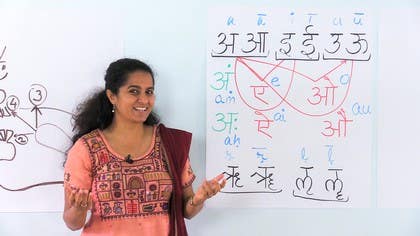Description
About This Video
Transcript
Read Full Transcript
Namaste. I hope you're really enjoying pronouncing the vowels and feeling how these sounds can start affecting your physiology. Now that I hope you have some kind of mastery over the vowels, let's see what the consonants look like. The consonants again in the Sanskrit alphabet correspond to these five places of pronunciation. That's the key. Just remember the order. Just remember the throat, the guttural, the palletals, the cerebrals, the dentals and the labials and you will be settled. So we have five consonants that correspond to each of these places of pronunciation. Remember that there are five per place of pronunciation. So we have 25 main consonants and there is a certain logic about them. The beauty of the Sanskrit alphabet is that it follows a very precise system of sound arrangement. So if you remember the logic then it becomes very easy to reproduce it. So I'll share the logic with you and then wherever you are, whenever you are, you can fall back on that logic and you will have it. So each of these places of pronunciation has the five letters. These letters are also known as akshara or indestructible. Maybe sometime I'll share with you what that means. But these five letters follow a very definite and regular system and that is the first one is a touch sound. So in the throat it would be a followed by the sound or the vowel a. So if you say together fast it is the k. Say that again k. If you want to break it up it is k. That's it k. So this corresponds to touch sound. The second letter is the same touch sound but with breath. k. The first one was k or k. The second one is just with the breath on that. k. Say it faster k. Let's combine it and see what it sounds like. k. k. Lovely. The next or the third letter is sound touch. g. You hear the sound first and then there is an element of touch. g. So the third letter is the g. Say that again g. And then we have the fourth sound which is a breath on that. g. lovely. We'll try and combine these four sounds. We have the k or the k breath. k sound touch. g breath. g. And the fifth sound is the nasal with that position. So it is the n. Once more n. As in if you want to say king. That's how it would sound like n. We'll now try and combine these five sounds. k. k. g. g. l. So I'll slow them down a little more so you can repeat after me. k. That's it. k. g. g. now let's see if you can say it along. k. k. g. g. l. Lovely. You're getting there. Remember the logic. The logic is important. touch sound breath sound touch breath nasal. Just repeat that logic once after me. touch sound breath sound touch breath nasal. Brilliant. Now this particular sequence of touch and sound combined with breath is followed throughout the different places of touch. So we had the first the guttural consonants of k. k. g. g. l. We then move on to the palatals. You can arrive at the palatals also by touching your tongue to the lower teeth. Behind the lower teeth. So it corresponds as well to the vowel e.
So if you do an e and then you say a ch somewhat similar. It's in that same group. So the first one again is a touch sound. So ch or a ch. Ch. And then you add a breath to that for the second letter. ch. Say that again. ch. Lovely. Then we have the third letter which is the j. So it's sound touch. j or the j. And then you have the ch. It's the sound as well as the breath. lovely. And then we have the nasal. You get it by keeping the tongue exactly in the same place but just add the nasal now. So it is the nnya. Let's see if we can say this together. So it's ch. ch. j. j. nnya. Got it? I think you can now just once try saying it after me. ch. Maybe you say twice also. ch. ch. With the breath. ch. ch. The sounded one. j. j. With the breath. j. j. The nasal. nnya. nnya. Fantastic. You're doing it really well. I'd also like to mention here that when we talk of touch sound in a more technical term it is considered as the unvoiced sound. So ch. ch. ch. or k. k are all unvoiced sounds. And then when you have the sound touch which is the g sounds or the j sounds they are considered as the voiced in technical terminology. So we have the unvoiced with a breath, voiced with a breath and then the nasal. We saw it at the palatals with the ch. ch. j. j. nnya. Now let's see what they sound like at the cerebral level. The cerebral is sometimes also known as the retroflex but cerebral will just do the job as well. So this I usually recommend that you learn it by initially placing your finger at the tip or in the center of the roof of your mouth. See if you can do it. Touch it there and then place your tongue on that point and make the sound. The first is remember the touch sound. So it's t. t. t. See that? t. Now what's interesting for those from the English speaking world is that these sounds don't exist in your language. In the English language one never ever does the t. the t sound does not exist. There is a t but it is more behind the teeth, behind the touch of the teeth with the gum there. Okay so that's the t of the English language. This one is a little different. You have to roll your tongue. You have to roll your tongue a little back to the center roof of your palate and there you pronounce the t. See that? t. Lovely. We follow the logic. So touch sound, breath, sound touch, breath, nasal. So the first being the t. The next is with the breath t. t. Try that. t. Very good. The third is the d. The sound and then the touch. d. d. Try that. d. Fantastic. The next one is a little harder. It's a d. You have to literally put your breath behind it. Got it? The last one in this series is the n or the nasalized. So place your tongue there, put your awareness on your nose and then do a n. You have it?
Okay let's try that once again. So place your tongue on the roof of your mouth and then say t. With your breath t. Then make the sound d. d. And the nasal n. Repeat it once after me and then we'll try saying it together. t. t. t. d. d. d. d. n. n. Let's see if we can do that fast together. t. t. d. d. n. You got that? Does it make you feel different? The beauty of this particular area of touch is that if you know of qigong a little bit, qigong talks of two meridians in the body and both these meridians meet at that axis point which is the roof of your palate of the mouth. So when you touch that point in a way you are actually stimulating the two axes or the two meridians of your body. Now that's really cool. The next series is the dental series. So we have moved up from the throat, the palate, the cerebrals and then the teeth. These sounds again don't exist in the English language. In the French and Spanish the latino speaking languages they figure completely but they don't have the cerebrals that we just saw a little before nor do they have the English ter sounds. So these sounds are the softer sounds and it's very important to pay attention to them because they can completely change the way you feel about these sounds or these sounds make you feel. So the first one is the touch sound which is the th or the th initially to get it right because yeah I've been trying doing this and I think to get it right it is important to maybe exaggerate it a little bit. So try and stick the tip of your tongue out of your mouth a little like that and feel the pressure of your teeth on the tip of your tongue. Th and then use the vowel a so the together say the and just to know the difference once place your tongue the way you regularly say your T in English. So try becoming sensitive to the difference of these two sounds. It's not the ter it's the the the lovely. The second one is with the breath. Got it? Then we have the sound and the touch which gives us the D sound but the softer version it's the the. Once more the lovely. Then we have the breath which is the da da say that da brilliant and then we have the dental or the nasal dental which is the nna nna. Become aware of the the vibration in your nose as you do that nna nna. Terrific. Now let's do this all together. We'll say it twice every letter so that you can get a feel of it. You repeat the second time after me so it's the the the the the the the the nna nna. Super. We'll try saying it together once. The the the the nna. You have it? Great. So now we've seen the guttural, the palatal, the cerebrals and the dentals. Five sounds in each of these categories. We then come to the final set of five sounds which are the labials or from the lips. The lips formulate this these sounds. So the first one is the sound per but again if you want to break it down into touch sound it is per. You add a breath to that and you get your second sound per per. Lovely. The third one is sound touch. And you add a breath to that it's bah bah and then you add the nasal. The fifth sound is the mmmah mmmah. Super. Let's try putting that together. Repeat it after me. We'll say every letter twice. per per per bah bah bah mmmah mmmah You got that? Did you observe also how it feels? Because pronouncing the Sanskrit letters is not just about saying the letters. It's a lot about feeling the impact of these sounds within the body. Becoming sensitive to the whole mechanism of sound that we mentioned earlier. And so we have now the guttural, the five sounds here, the palatal, the cerebrals, the dentals and the labials. We have covered the whole range of the consonants corresponding to these five places of pronunciation. And what we also notice at the same time if you are trying to remember how these or what is the order of these sounds just remember the way in which the sound rolls out of your vocal system and you will remember the order of these five letters that come through. So these 25 consonants we can just try saying them all once together. I would suggest maybe you repeat the letter after me. We'll do every letter twice so that you get a feel of it. We start with the guttural. They are the k, k, k, k, k, g, g, g, g, n, n, yes. We go on to the next group of palatals. We have the ch, ch, ch, ch, ch, ch, j, j, j, j, j, n, n, n, lovely. We move on to the next group, the cerebrals. We do every letter twice. Remember to place your tongue on the roof of your palate right at the center of it. Be very conscious of this place of pronunciation. And do it as doh, doh, doh, doh, doh, nuh, nuh, nuh, nuh, nuh, fantastic. You're getting it. We next move on to the next group of letters corresponding to the dentals. Again, you need to pay very careful attention to that, especially if you come from the English part of the world, the English speaking world. Pay attention to where your tongue is placed and become sensitive to the quality of the sound. That is key. So to exaggerate maybe initially, stick your tongue out a little bit. We repeat every letter twice. The. The. The. The. The. The. The. The. The. You got it? I'm sure you're getting it right. We next move on to the lips or the labials. There are five letters there as well. We do each letter twice. We start. B. B. B. B. B. B. B. B. B. B. Super.
If you've got it, you can feel the difference of the sound as it moves through your vocal system. As we do these letters, just the consonants, we do quite a few things actually. One is that because there is such a systematic organisation of touch and sound in the different parts of your vocal system, in a certain manner you can consider it as giving yourself a brain massage as you go through these letters and that kind of brain massage, I often like to joke and say that the result is that you can get very good hair growth, try it out, it might just work you know. So we have these different letters that correspond to these places. I think just once I'll do it all together without any break so that if you'd like to join along, you can just get a feel of what it does to your body. So just relax and see what these sounds are doing to your system. You can even close your eyes and do it if you like. D, D, D, N, D, D, D, N, B, P, B, B, H, H, M, M. So when we are saying these sounds, we are doing many things. We are combining our breath with the different places of touch that correspond to the different chakras within us and therefore becoming familiar with these Sanskrit sounds is not just learning another alphabet of another language called Sanskrit. It is really a whole process of awakening by becoming sensitive to sound and its effect on the body. So just enjoy this process. Enjoy this process of playing, of discovering your vocal system. Enjoy this process of the different sounds that correspond to these different places of touch and you will see the magic begin to happen with you.
Mother Tongue: The Sound of Sanskrit
Comments
You need to be a subscriber to post a comment.
Please Log In or Create an Account to start your free trial.




















